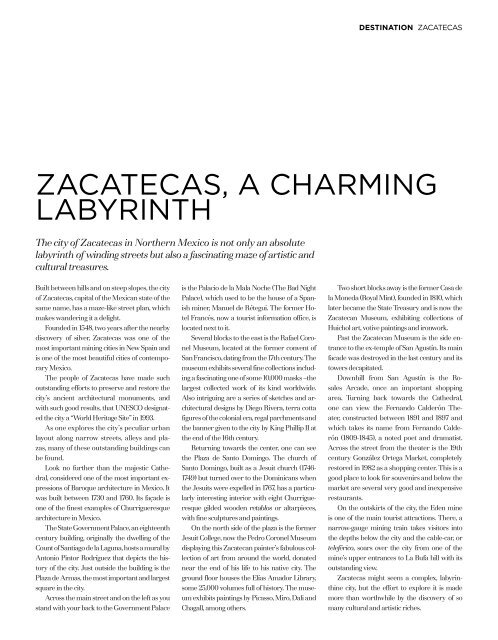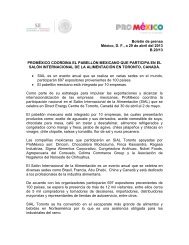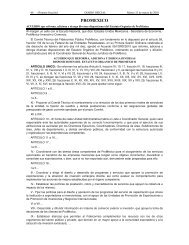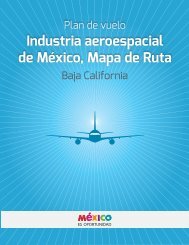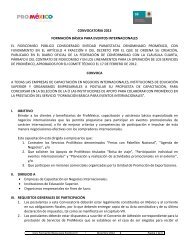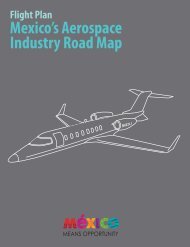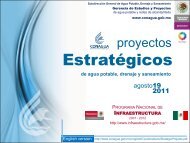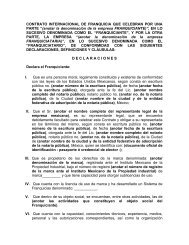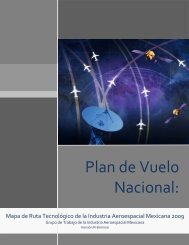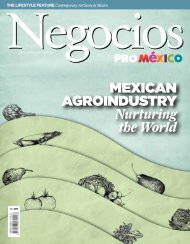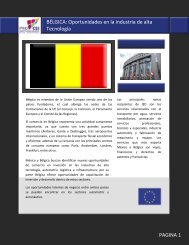MINING IN MEXICO S - ProMéxico
MINING IN MEXICO S - ProMéxico
MINING IN MEXICO S - ProMéxico
You also want an ePaper? Increase the reach of your titles
YUMPU automatically turns print PDFs into web optimized ePapers that Google loves.
destination zacatecas<br />
Zacatecas, A Charming<br />
Labyrinth<br />
The city of Zacatecas in Northern Mexico is not only an absolute<br />
labyrinth of winding streets but also a fascinating maze of artistic and<br />
cultural treasures.<br />
Built between hills and on steep slopes, the city<br />
of Zacatecas, capital of the Mexican state of the<br />
same name, has a maze-like street plan, which<br />
makes wandering it a delight.<br />
Founded in 1548, two years after the nearby<br />
discovery of silver, Zacatecas was one of the<br />
most important mining cities in New Spain and<br />
is one of the most beautiful cities of contemporary<br />
Mexico.<br />
The people of Zacatecas have made such<br />
outstanding efforts to preserve and restore the<br />
city’s ancient architectural monuments, and<br />
with such good results, that UNESCO designated<br />
the city a “World Heritage Site” in 1993.<br />
As one explores the city’s peculiar urban<br />
layout along narrow streets, alleys and plazas,<br />
many of these outstanding buildings can<br />
be found.<br />
Look no further than the majestic Cathedral,<br />
considered one of the most important expressions<br />
of Baroque architecture in Mexico. It<br />
was built between 1730 and 1760. Its façade is<br />
one of the finest examples of Churrigueresque<br />
architecture in Mexico.<br />
The State Government Palace, an eighteenth<br />
century building, originally the dwelling of the<br />
Count of Santiago de la Laguna, hosts a mural by<br />
Antonio Pintor Rodríguez that depicts the history<br />
of the city. Just outside the building is the<br />
Plaza de Armas, the most important and largest<br />
square in the city.<br />
Across the main street and on the left as you<br />
stand with your back to the Government Palace<br />
is the Palacio de la Mala Noche (The Bad Night<br />
Palace), which used to be the house of a Spanish<br />
miner, Manuel de Rétegui. The former Hotel<br />
Francés, now a tourist information office, is<br />
located next to it.<br />
Several blocks to the east is the Rafael Coronel<br />
Museum, located at the former convent of<br />
San Francisco, dating from the 17th century. The<br />
museum exhibits several fine collections including<br />
a fascinating one of some 10,000 masks –the<br />
largest collected work of its kind worldwide.<br />
Also intriguing are a series of sketches and architectural<br />
designs by Diego Rivera, terra cotta<br />
figures of the colonial era, regal parchments and<br />
the banner given to the city by King Phillip II at<br />
the end of the 16th century.<br />
Returning towards the center, one can see<br />
the Plaza de Santo Domingo. The church of<br />
Santo Domingo, built as a Jesuit church (1746-<br />
1749) but turned over to the Dominicans when<br />
the Jesuits were expelled in 1767, has a particularly<br />
interesting interior with eight Churrigueresque<br />
gilded wooden retablos or altarpieces,<br />
with fine sculptures and paintings.<br />
On the north side of the plaza is the former<br />
Jesuit College, now the Pedro Coronel Museum<br />
displaying this Zacatecan painter’s fabulous collection<br />
of art from around the world, donated<br />
near the end of his life to his native city. The<br />
ground floor houses the Elías Amador Library,<br />
some 25,000 volumes full of history. The museum<br />
exhibits paintings by Picasso, Miro, Dali and<br />
Chagall, among others.<br />
Two short blocks away is the former Casa de<br />
la Moneda (Royal Mint), founded in 1810, which<br />
later became the State Treasury and is now the<br />
Zacatecan Museum, exhibiting collections of<br />
Huichol art, votive paintings and ironwork.<br />
Past the Zacatecan Museum is the side entrance<br />
to the ex-temple of San Agustín. Its main<br />
facade was destroyed in the last century and its<br />
towers decapitated.<br />
Downhill from San Agustín is the Rosales<br />
Arcade, once an important shopping<br />
area. Turning back towards the Cathedral,<br />
one can view the Fernando Calderón Theater,<br />
constructed between 1891 and 1897 and<br />
which takes its name from Fernando Calderón<br />
(1809-1845), a noted poet and dramatist.<br />
Across the street from the theater is the 19th<br />
century González Ortega Market, completely<br />
restored in 1982 as a shopping center. This is a<br />
good place to look for souvenirs and below the<br />
market are several very good and inexpensive<br />
restaurants.<br />
On the outskirts of the city, the Eden mine<br />
is one of the main tourist attractions. There, a<br />
narrow-gauge mining train takes visitors into<br />
the depths below the city and the cable-car, or<br />
teleférico, soars over the city from one of the<br />
mine’s upper entrances to La Bufa hill with its<br />
outstanding view.<br />
Zacatecas might seem a complex, labyrinthine<br />
city, but the effort to explore it is made<br />
more than worthwhile by the discovery of so<br />
many cultural and artistic riches.


